Solve the following attachments
Question #2; Two firms are deciding simultaneously whether to enter a market. If neither enters, they make zero profits. If both enter, they make profits -1, since the market is too small for two firms. If only one enters, that firm makes high profits. This game is summarized in the following matrix: Firm 2 H Firm 1 Enter Do not enter Enter -1, -1 10, 0 Do not enter 0. 5 al. What are the pure-strategy Nash Equilibria of this game, if any? by Now assume that firm 1 can enter the market with probability p and firm 2 can enter the market with probability q. Write down the expected payoff of each firm for each course of action (enter, do not enter). cl Find the Nash equilibria in mixed strategies. O e P W acer(3) You and a classmate are assigned a project on which you will receive one combined grade. You each want to receive a good grade, but you also want to avoid hard work. In particular, here is the situation: If you both work hard, you get an A, which gives you each 40 units of happiness .If only one of you works hard, you both get a B, which gives you each 30 units of happiness. .If neither of you works hard, you both get a D, which gives each of you 10 units of happiness. . Working hard costs 25 units of happiness. (a) Fill in the following payoff matrix: Your decision Work Shirk Classmate's Work decision Shirk (b) What is the likely outcome? Explain your answer. T (c) If you get this classmate as your partner on a series of projects throughout the year, rather than only once, how might that change the outcome you predicted in part (b)?1. (15 points) For the exercises below, transform the regression equation Yi = 60 +81Xli +$2X2i +pi so that you can use a t-statistic to test for the following restrictions. Show all your steps for full credit. a. (5 points) B1 = 1262 b. (5 points) B1 - 82 = 2 a) If we assume normality of u, then we know the exact distribution of B1, a t student b) If we do not assume normality of u but n is large, then we approximate the sampling distribution 3 2. (15 points) Consider the following model to explain CEO salaries in terms of various factors: salary = 30 + Blsales + $2mktval + 83ceoten + u, where: salary = 1990 compensation, $1000s; sales = 1990 firm sales, millions; mktval = market value, end 1990, mills; ceoten = years as ceo with company Next you perform the following regression: * R2 = 0.2013, SER = 529.67 a) (5 pts) What does each estimated coefficient on the individual variables (and constant term) mean quantitatively (do not worry about standard errors, as they are not given, or the measures of fit)? b) (5 pts) What is the forecasted salary of a CEO working in a firm with sales equal to 5,000 millions, market value equal to 10,000 millions, and 10 years of tenure? c) (5 pts) Eliminating the variable sales from your regression, the estimation regression becomes:" salary = 613.436 + .019sales + .023mktval + 12.703ceoten + u salary = 641.059 + .0369mktval + 11.525ceoten + u R2 = 0.184, SER = 533.58 Why do you think that the effect of mktval has changed now over part b. (very briefly describe)?Font Select . Paragraph Styles Editing Graph the following scenario. (Hint: the graph setup in question #8 is a good framework) For a real world example, consider the market for oil. The initial supply and demand curves would be at position 1 (p1). When the suppliers decide to collaborate and supply less oil for every price, this causes a backwards shift in the supply curve, to supply curve 2. This cuts the quantity supplied from quantity 1 (q1) to quantity 2 (q2] and raises the price paid for oil along demand curve 1. We can either shift the demand curve in to curve 2, maintaining previous price levels, but decreasing consumption even more, or we can shift our demand curve out to curve 3, maintaining previous levels of consumption but raising prices. Since there is a tradeoff between having steady prices or steady consumption, the consumers have to make a decision about which is more important to them. In the short run, they will probably decide to pay the higher prices to keep consumption steady (that is, they will shift out to curve 3), but if the prices stay high for a long time, they will start finding ways to economize, (thereby shifting in to curve 2]. 10. What terms are being defined? a. Situation in which the quantity supplied exceeds the quantity demanded for a good or service; price is above equilibrium price. Additional income derived from each additional unit of goods sold. Total Variable Costs divided by quantity sold, TVC/q- Total Fixed Costs divided by quantity sold, TFC/q. To maximize utility by making the most effective use of available resources, whether they be money, goods, or other factors. Costs which do not vary with quantity produced that a firm has to pay in order to produce and sell its goods. Total revenue










